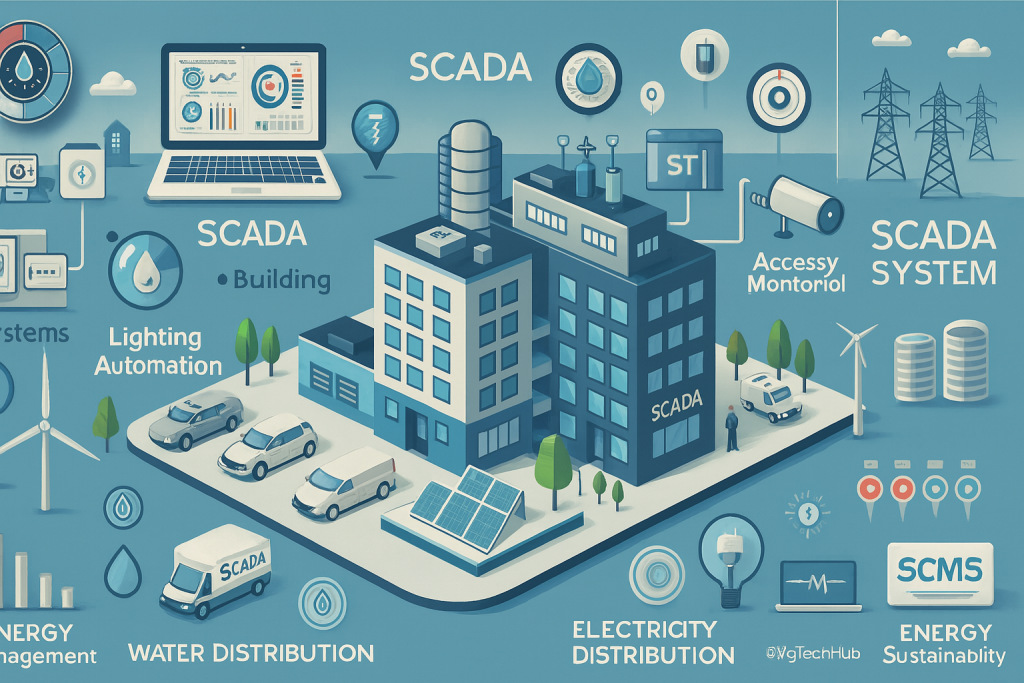SCADA System Applications in Energy Management
SCADA (Supervisory Control and Data Acquisition) systems play a crucial role in energy management, helping industries, utilities, and buildings monitor, control, and optimize energy consumption. By integrating real-time monitoring, automation, and predictive analytics, SCADA systems ensure efficient power distribution, cost savings, and sustainable energy use.

1. SCADA in Power Grid Management
SCADA is widely used in power transmission and distribution networks to maintain grid stability and efficiency.
Applications in Power Grid Management
✅ Real-Time Monitoring
- Tracks voltage, current, and frequency across power lines.
- Detects faults, voltage drops, and irregular power flows.
✅ Load Balancing & Demand Response
- Adjusts power distribution based on real-time demand fluctuations.
- Prevents grid overload and optimizes energy allocation.
✅ Automated Fault Detection & Isolation
- Identifies faults, outages, and equipment failures.
- Automatically reroutes power to unaffected areas, reducing downtime.
Key Benefits
✔️ Improves power reliability by reducing outage durations.
✔️ Prevents grid failures with automated load balancing.
✔️ Reduces maintenance costs through predictive fault detection.
📌 Example: Smart Grid Implementation
- SCADA reduced power outages by 50% and improved load management.
2. SCADA in Renewable Energy Integration
With the rise of solar, wind, and hydro energy, SCADA systems help utilities manage intermittent renewable power sources.
Applications in Renewable Energy Management
✅ Solar Power Monitoring
- Tracks solar panel output, efficiency, and weather conditions.
- Adjusts panel angles for maximum energy generation.
✅ Wind Farm Optimization
- Monitors wind speed, turbine rotation, and energy production.
- Controls blade angles to optimize wind capture.
✅ Battery Energy Storage Management
- Stores excess renewable energy for later use.
- Balances supply and demand by controlling battery charge cycles.
Key Benefits
✔️ Optimizes renewable energy output for higher efficiency.
✔️ Ensures grid stability by balancing supply and storage.
✔️ Reduces reliance on fossil fuels, supporting sustainability.
📌 Example: Wind Farm Optimization
- SCADA increased wind energy efficiency by 20%, reducing energy losses.
3. SCADA in Industrial Energy Management
Industries consume vast amounts of energy, and SCADA helps optimize consumption, reduce costs, and enhance efficiency.
Applications in Industrial Energy Management
✅ Energy Usage Monitoring
- Tracks real-time power, gas, and water consumption.
- Identifies inefficiencies in machinery and processes.
✅ Predictive Maintenance
- Monitors motors, compressors, and transformers.
- Reduces unexpected breakdowns and waste.
✅ Peak Demand Management
- Shifts heavy processes to off-peak hours.
- Implements automated energy-saving schedules.
Key Benefits
✔️ Reduces industrial energy costs by up to 30%.
✔️ Extends equipment lifespan with predictive insights.
✔️ Improves sustainability by reducing waste.
📌 Example: Automotive Manufacturing Plant
- SCADA cut energy costs by 25% by optimizing machine usage.
4. SCADA in Smart Buildings & Energy Efficiency
SCADA is widely used in commercial buildings, hospitals, and campuses for efficient energy use.
Applications in Smart Energy Management
✅ Lighting & HVAC Automation
- Adjusts lighting and temperature based on occupancy.
- Uses daylight harvesting to reduce waste.
✅ EV Charging Management
- Monitors EV charging stations to optimize load.
- Prevents overload during peak times.
✅ Carbon Footprint Reduction
- Tracks CO₂ emissions and energy efficiency.
- Supports green building standards like LEED & ISO 50001.
Key Benefits
✔️ Lowers electricity bills through smart automation.
✔️ Improves occupant comfort while saving energy.
✔️ Supports carbon neutrality goals.
📌 Example: Smart University Campus
- SCADA reduced energy usage by 30%, improving sustainability.
5. SCADA in Energy Analytics & Reporting
Data-driven insights are essential for optimization and compliance.
Applications in Energy Data Management
✅ Real-Time Dashboards
- Displays live energy usage and cost breakdowns.
- Helps managers make informed savings decisions.
✅ Historical Data Analysis
- Analyzes long-term consumption patterns.
- Identifies areas for efficiency improvements.
✅ Compliance & Reporting
- Generates reports for audits and regulators.
- Supports ISO 50001 energy management standards.
Key Benefits
✔️ Improves decision-making with actionable insights.
✔️ Ensures regulatory compliance.
✔️ Reduces costs by detecting inefficiencies.
📌 Example: Smart Grid Data Analytics
- SCADA cut energy waste by 15% by analyzing patterns.
6. SCADA in Microgrids & Distributed Energy
Microgrids are gaining popularity for localized energy production. SCADA ensures seamless integration of distributed energy resources (DERs).
- Manages solar rooftops, wind turbines, and local storage.
- Provides islanding capability to operate independently during grid failures.
- Balances local consumption vs. generation in communities.
- Improves resilience in remote areas and military bases.
📌 Example: Remote Island Microgrid
- SCADA helped achieve 70% renewable penetration with stable supply.
7. SCADA in Oil, Gas & Utilities Energy Operations
Energy companies use SCADA to optimize exploration, refining, and distribution.
- Monitors pipelines, compressor stations, and refineries.
- Detects leaks, corrosion, and safety hazards early.
- Automates gas distribution and billing systems.
- Ensures compliance with environmental safety standards.
📌 Example: Gas Utility Network
- SCADA reduced pipeline leak incidents by 40%.
8. Future of SCADA in Energy Management
The future lies in AI, IoT, and blockchain integration.
- AI-driven forecasting predicts demand and renewable fluctuations.
- IoT sensors provide granular energy data from millions of devices.
- Blockchain enables secure peer-to-peer energy trading.
- Digital twins simulate energy systems for optimization.
Looking forward, SCADA will act not just as a monitoring system but as an intelligent energy orchestrator. It will empower governments, industries, and consumers to transition to cleaner energy, reduce carbon emissions, and achieve sustainability goals. From smart homes to global power grids, SCADA will remain the nervous system of energy management.
